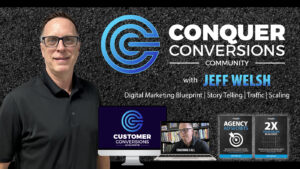When was the last time you went to the grocery store for one item and came out with just that item? If you’re anything like I am, that is a rare occasion. I tend to throw in several other items before I get through the checkout line. All too often it’s with things I need but didn’t realize it until I was walking through the store. Why is this? Because the grocery stores know their customers. They know exactly what they want all throughout the year. It’s like they are reading our minds.
We know this is not the case though. They have just spent an incredible amount of time studying our habits. They know us better than we do, so they deliver to our needs. It’s like a finely orchestrated dance. The same goes for your customers. You should know your customers better than they know themselves and you should care about solving their problems more than they do. When you do this, they will have no problem paying you to solve their problems for them.
In part five of our ten part series, we’ll take a closer look at the steps one should take to truly understand their targeted audience.
Knowing Your Target Audience
One of the most critical aspects of running a successful targeted ad campaign is knowing your audience. Without a deep understanding of who your ideal customers are, even the most well-crafted ads and offers can fall flat. For small business owners, this step is essential to avoid wasting time, effort, and money on campaigns that miss the mark. When you know your audience intimately, you can create ads that resonate, engage, and convert.
The first step in understanding your audience is defining who they are. This goes beyond basic demographics like age, gender, or location. While those are important, you need to dig deeper into their behaviors, preferences, and pain points. Ask yourself: What challenges does my audience face? What are their goals and aspirations? What motivates their purchasing decisions? By answering these questions, you begin to build a detailed profile of your ideal customer, often referred to as a “buyer persona.”
Creating buyer personas helps you get specific. For instance, instead of targeting “women aged 25-40,” you might refine your audience to “working mothers aged 25-40 who value convenience and are seeking ways to simplify their daily routine.” The more specific you are, the more effective your ads will be in speaking directly to their needs and desires.
Understanding your audience also means knowing where they spend their time online. Are they active on Instagram, Facebook, or LinkedIn? Do they prefer watching videos on YouTube or engaging with stories on social media? By identifying the platforms your audience frequents, you can ensure your ads appear in the right place at the right time. This not only increases your chances of reaching them but also ensures your ad spend is being used efficiently.
Another critical aspect of knowing your audience is understanding their buyer journey. Some people are ready to purchase immediately, while others need more nurturing. Tailor your messaging to align with where your audience is in the buying process. For example, if you’re targeting people who are just becoming aware of their problem, your ads might focus on education and building trust. For those closer to making a decision, your ads can emphasize your unique value proposition and include a clear call-to-action.
Leverage data to gain insights into your audience. Analytics from your website, social media platforms, and past ad campaigns can reveal patterns in behavior and preferences. What types of content do they engage with most? Which products or services are they drawn to? Tools like Facebook Audience Insights or Google Analytics can help you refine your understanding and make informed decisions about your targeting.
Don’t overlook the importance of testing and adapting. Even the most well-researched audiences evolve over time. Test different messaging, visuals, and offers to see what resonates best. Analyze the results, and be ready to adjust your approach based on the data. This iterative process ensures your campaigns remain relevant and effective as your audience’s needs and behaviors shift.
Knowing your audience isn’t just about identifying who you’re targeting—it’s about building a connection with them. When your ads speak directly to their needs, interests, and aspirations, they’re more likely to engage and take action. For small business owners, this connection is the foundation of profitable ad campaigns that deliver results. By deeply understanding your audience, you create campaigns that don’t just capture attention—they capture hearts and wallets.
CONQUER CONVERSIONS COMMUNITY
Interested in further support to help conquer conversions for your business?
 I have created a special community where I share all the secrets I have developed over the last decade. My new group known as the Conquer Conversions Community can be found over on the Skool platform.
I have created a special community where I share all the secrets I have developed over the last decade. My new group known as the Conquer Conversions Community can be found over on the Skool platform.
In the group, I teach how to increase online 💰 sales! You get the system & blueprint (step-by-step guide) we use to help businesses build & scale their online offers to achieve sales growth in a short period of time.
For a limited time, you can join for FREE, but it won’t be that way for long. Actually, the ability to join at no cost will end on December 1. At that time the community will be a paid group to be a part of, so don’t miss an opportunity to grow for FREE and join here today!

Warmest Regards,
Jeff Welsh
Founder | Leader
WelshTraining.com
Let’s Connect
